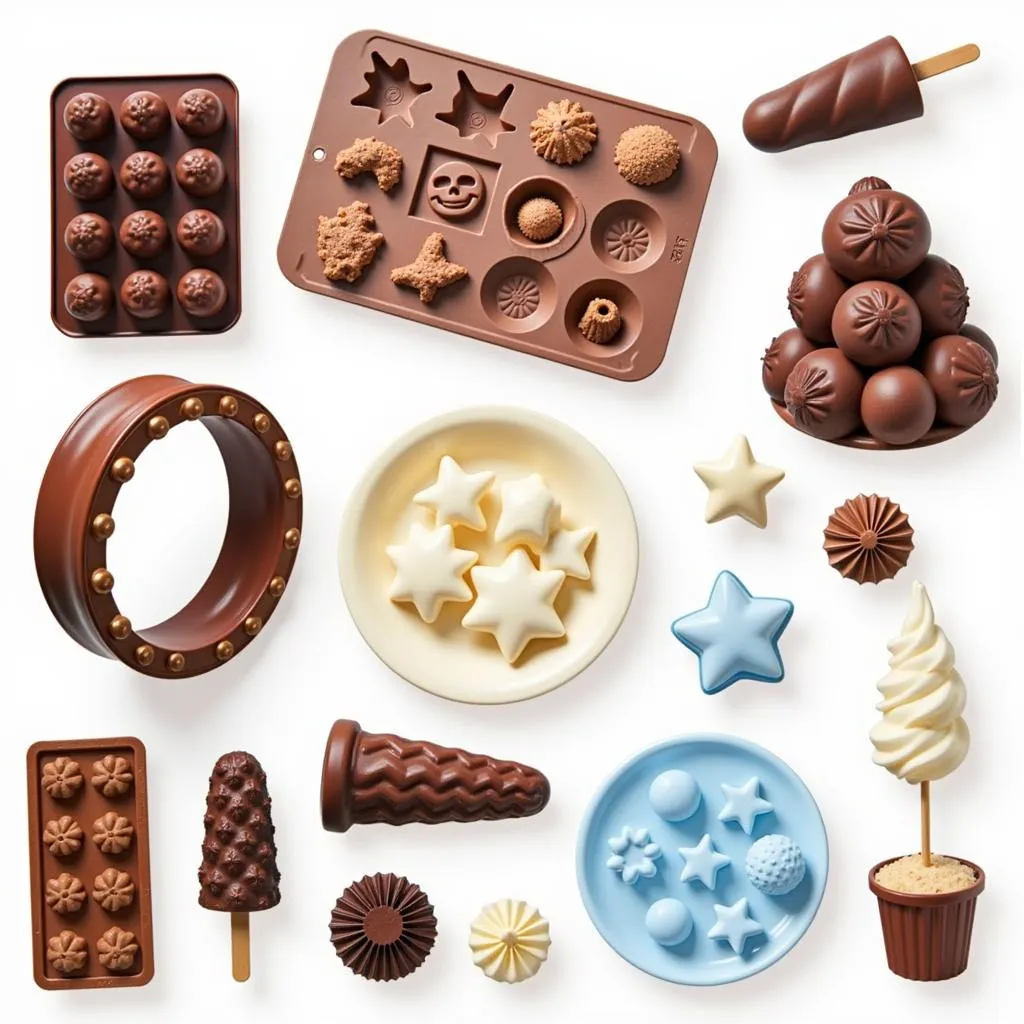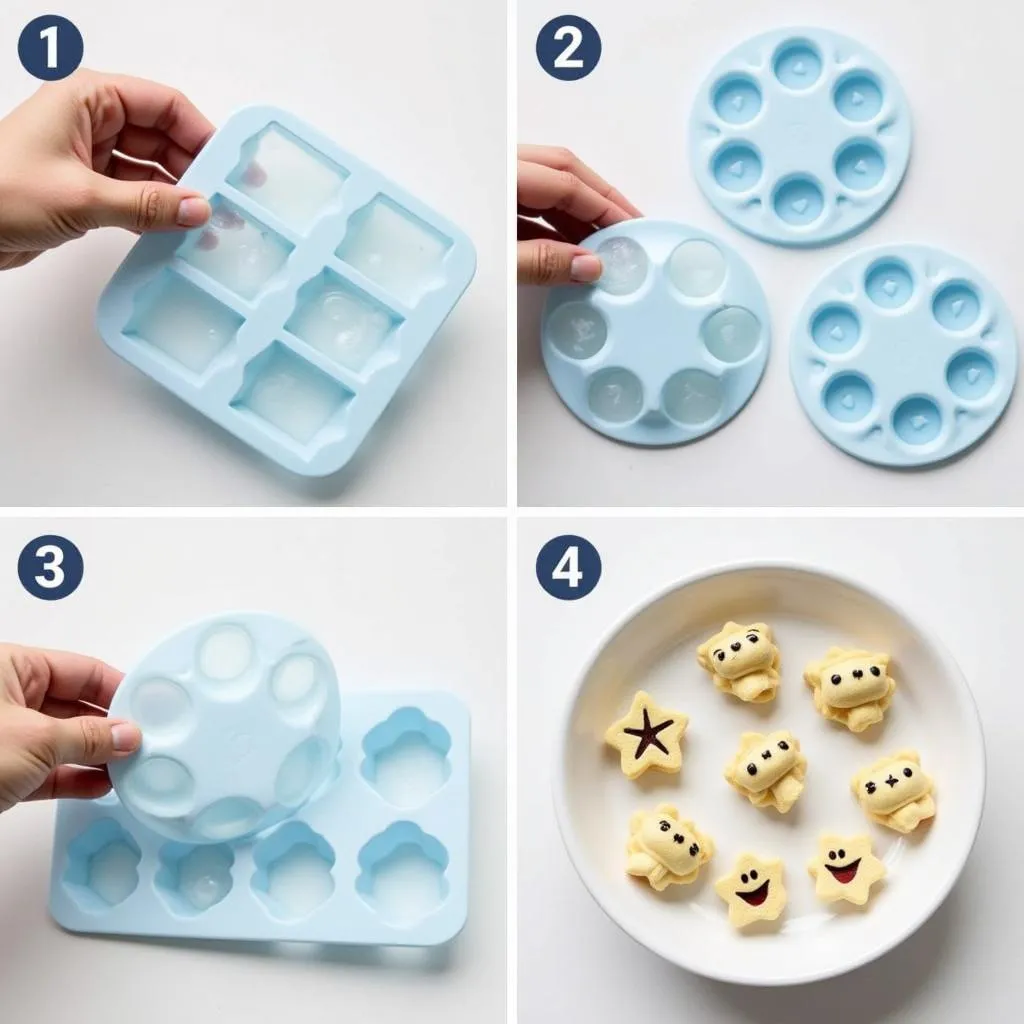Food Molds. These simple tools might not seem like much at first glance, but they have the power to transform your culinary creations from ordinary to extraordinary. Whether you’re a seasoned baker or a kitchen novice, food molds open up a world of possibilities, allowing you to craft visually stunning and delicious dishes that will impress your friends and family.
 A variety of food molds for baking and cooking.
A variety of food molds for baking and cooking.
Why Use Food Molds?
Food molds offer a range of benefits that can elevate your cooking and baking:
- Professional-Looking Results: Achieve bakery-style perfection at home with intricate designs and shapes that would be difficult to create freehand.
- Portion Control: Create consistently sized portions, ideal for desserts, appetizers, or individual servings.
- Endless Creativity: Experiment with different ingredients, flavors, and designs to make truly unique culinary masterpieces.
- Time-Saving Solutions: Some molds, like those for ravioli or cake pops, can significantly reduce preparation time.
Exploring the World of Food Molds
From simple shapes to elaborate designs, there’s a food mold for every need and skill level:
Material Matters: Choosing the Right Mold
Food molds are made from various materials, each with pros and cons:
- Silicone: Flexible, non-stick, and easy to clean, silicone molds are perfect for intricate designs and releasing delicate treats. They are also oven, microwave, and freezer safe.
- Plastic: Affordable and readily available, plastic molds are a good option for beginners. However, they may not be as durable or heat-resistant as silicone.
- Metal: Durable and excellent for heat conduction, metal molds are ideal for creating sharp edges and intricate details. They are best suited for experienced bakers.
![]() Silicone molds in a variety of shapes, like hearts, stars, and animals.
Silicone molds in a variety of shapes, like hearts, stars, and animals.
Shapes and Sizes: Finding the Perfect Fit
Food molds come in an astounding array of shapes and sizes:
- Basic Shapes: Round, square, loaf, and muffin molds are kitchen staples for everyday baking.
- Novelty Shapes: Heart-shaped molds for Valentine’s Day, pumpkin molds for Halloween, or animal shapes for children’s parties add a touch of fun and festivity.
- Specialized Molds: Cake pop molds, ice cream molds, chocolate molds, and even molds for making decorative butter pats cater to specific culinary creations.
“When choosing a food mold, consider the recipe you want to make and the visual impact you want to achieve,” advises Chef Emily Carter, a renowned pastry chef known for her innovative use of molds. “Don’t be afraid to experiment and have fun with it!”
Tips for Using Food Molds Like a Pro
- Grease or Line Your Molds: Prevent sticking by greasing your molds with butter or cooking spray, or lining them with parchment paper, especially when using metal molds.
- Fill Carefully: Avoid overfilling your molds, as this can cause spills and uneven cooking.
- Temperature Control: Adhere to recipe-recommended temperatures and baking times, as different materials may require adjustments.
- Demolding with Ease: Allow your creations to cool slightly in the mold before inverting them onto a cooling rack. This will help prevent breakage.
- Cleaning and Storage: Wash your molds thoroughly with warm soapy water and dry them completely before storing to prevent mold and mildew growth.
 Steps for making shaped ice cubes using a food mold.
Steps for making shaped ice cubes using a food mold.
Conclusion
Food molds are more than just baking tools; they are gateways to culinary creativity. With a little imagination and the right mold, you can transform ordinary ingredients into edible works of art. So, unleash your inner chef, explore the world of food molds, and discover a universe of delicious possibilities!
FAQ
1. Can I use metal food molds in the microwave?
No, metal should never be used in the microwave. It can cause damage to your microwave and create a fire hazard.
2. How do I prevent my cake from sticking to the silicone mold?
Greasing the mold with butter or cooking spray or lightly dusting it with flour usually prevents sticking. You can also use parchment paper liners for added protection.
3. Are food molds dishwasher safe?
While some food molds are dishwasher safe, it’s always best to check the manufacturer’s instructions. Handwashing is often recommended to prolong the life of your molds.
4. Can I use food molds for crafts?
Yes, many food-grade silicone molds can be used for crafts involving resin, soap making, and other non-toxic materials.
5. Where can I find unique and specialized food molds?
Specialty baking stores, online retailers like Amazon, and even craft stores often carry a wide selection of food molds.
Need Help?
For personalized assistance and guidance on finding the perfect food mold for your needs, please contact us:
Phone: 02437655121
Email: minacones@gmail.com
Visit Us: 3PGH+8R9, ĐT70A, thôn Trung, Bắc Từ Liêm, Hà Nội, Việt Nam
Our dedicated customer service team is available 24/7 to answer your questions and provide expert advice.
Discover more culinary inspiration and explore our range of products on our website:
- Check out our collection of funny food ornaments.
- Indulge your sweet tooth with our fast food gummy candy.